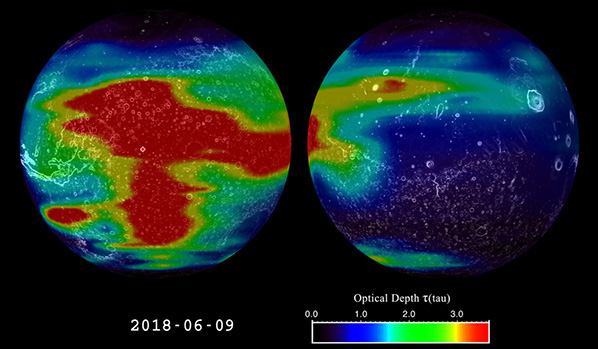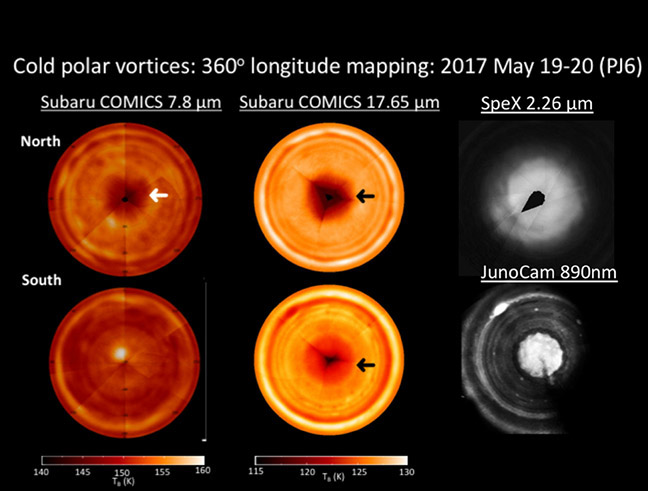Atmospheric science makes up a small aspect of planetary research, but by interpreting the motion and composition of these atmospheres, we can gain an outsized understanding of the origin and evolution of planetary systems.
The study of planetary and exoplanetary atmospheres spans a breadth of techniques and disciplines which seek an understanding of the climate, dynamics, and chemistry of atmospheres both in our solar system and beyond. As applied at JPL, research in planetary and exoplanetary atmospheres encompasses ground-based, aerial, and orbiting telescopic observations, spacecraft experiments to follow up on discoveries, and computer simulations and numerical models to understand and contextualize these observations. Nearly all large bodies in our solar system harbor some form of atmosphere, from the tenuous ethers of Pluto, Triton, and the Galilean moons of Jupiter, to the modest envelopes of Venus, Earth, Mars, and Titan, to the deep, thick soups of the gas giants Jupiter and Saturn, and the ice giants Uranus and Neptune.
Many observed exoplanets are surrounded by deep atmospheres like those of the gas and ice giants; the light observed from these planets is strongly influenced by the composition of their atmospheres. Smaller terrestrial exoplanets may have atmospheres more closely resembling Earth, and which may harbor habitable environments. By studying the diversity of terrestrial bodies in our own solar system and their divergent climatologies, we may better interpret the signals returned from these planets outside our solar system.
Current Challenges
Planetary and exoplanetary atmosphere research at the Jet Propulsion Laboratory is geared towards addressing many scientific challenges, including the following:
Meteorological assessment of the Martian atmosphere

Understanding the water cycle on Mars today is key to understanding the environment of ancient Mars, which had standing bodies of water and precipitation, and how the ancient wet Mars climate transitioned into today’s dry environment. The details of how water currently exchanges between reservoirs are poorly known. We need to characterize the transport of water between surface and atmospheric reservoirs via atmospheric circulation. To gain insight into this area, JPL is developing an in-situ, short-range radar, WASSR (WAter Sounding Short-range Radar), to be operated on the Martian surface, that could measure near-field profiles of water vapor to better characterize the surface-atmosphere exchange at all times of day. Surface-atmosphere vapor exchange regulates ice content in the near-subsurface, plays a role in hydrating hygroscopic salts, and impedes long-distance atmospheric transport of vapor. WASSR could measure absolute water vapor abundances to a few parts per million across all temperature conditions. The instrument is compact, low mass, and low power, so that it can be proposed for future Mars landers and rovers.
Quantifying the occurrence and development of dust storms on Mars

Dust storms are among the most prominent features in the atmosphere of Mars. They frequently occur on local and regional scales, though some grow into global dust events (GDEs), enshrouding the planet for months at a time. These global events have profound effects on Martian atmospheric dynamics and chemistry -- heating the atmosphere, increasing the strength of the meridional atmospheric circulation, and enhancing photolysis of water vapor transported into the upper atmosphere. They also have significant impact on the operation of robotic spacecraft -- the Opportunity rover was lost during the recent 2018 GDE. The reasons why some regional storms turn into global events remain a mystery. Scientists at JPL use an instrument called the Mars Climate Sounder (MCS) onboard the Mars Reconnaissance Orbiter (MRO) to study these dust events on Mars. MCS is a passive, limb-sounding filter radiometer designed and built at JPL, operating in the mid-to-far infrared wavelength range. Uncooled, linear arrays of thermopile detectors are the enabling technology of MCS. Developed and fabricated at JPL, they allow radiance measurements with high signal-to-noise ratios even at low scene temperatures. Continuous profiling from low Mars orbit provides 3-D distributions of dust during the initiation, growth, and decay phases of regional and global dust events as well as the atmospheric thermal response, shedding light on transport and feedback processes during these events.
Enhancing Juno observations of the polar atmosphere of Jupiter

The Juno mission provides a number of unique perspectives on the poorly explored polar regions of Jupiter. Besides auroral phenomena, due to ions in the atmosphere, the spacecraft reveals much about the neutral (non-electrically charged) atmosphere at the poles, which has been difficult to observe because of the very oblique perspective of Earth-based observations and because almost all visiting spacecraft have flown in near-equatorial trajectories or orbits. JPL scientists add information about the poles by providing an independent measurement of temperatures using ground-based instruments sensitive to the mid-infrared, which is not covered by Juno. Using the Subaru Telescope’s COMICS instrument, scientists create temperature maps of Jupiter’s polar troposphere and stratosphere that can determine temperatures near the tropopause and in the stratosphere. The general polar region is defined in the troposphere by a cold vortex in the northern stratosphere (seen at 7.8 µm) and in both hemispheres in the troposphere (seen at 17.65 µm). The cold polar vortex boundaries are coincident with the boundaries of a polar haze, observed by NASA’s Infrared Telescope Facility (IRTF) in reflected sunlight in the near infrared, indicating that the haze is being constrained by dynamical forces associated with the temperature gradient across the polar vortex. JPL’s High-Speed Computing facilities are used to invert these observations to determine physical temperatures in the polar troposphere and stratosphere.
Direct imaging of exo-Earths

For direct imaging of exo-Earths, the JPL-developed Super-Lyot Exo-Earth Coronagraph (SLEEC) is innovating coronagraph designs targeting the HabEx (Habitable Exoplanet Observatory) and LUVOIR (Large UV/Optical/IR Surveyor) mission concepts. This effort leverages accomplishments and experience in designing coronagraphs for the WFIRST (Wide Field InfraRed Survey Telescope) project’s coronagraph instrument, learning to mitigate parasitic scattering from the telescope support structure and unavoidable thermal & mechanical disturbances. JPL’s innovation includes a new, global optimization algorithm that jointly optimizes design parameters in multiple optical planes, and adds unique capabilities in fabricating multi-layer optical masks with profiles in multiple dimensions.
Modeling of planetary atmospheres (Venus)
Because of the infrequent nature of planetary surface exploration, numerical models are used to simulate the atmospheric conditions on a variety of planetary bodies – Mars, Titan, Venus, etc. -- and as a way to augment the limited direct observational data returned from surface landers and rovers. Venus is particularly difficult to observe directly because of its extraordinarily harsh environmental conditions; probes sent to the surface tend to survive only for a day or two. A JPL study has been performed, investigating the general characteristics of the Venus lower atmosphere and chemical species mixing under these conditions. Starting from available data, the general thermodynamics and transport properties of the Venus lower atmosphere are computed at different altitudes. The characteristic non-dimensional Reynolds number is estimated for different assumed length scales, showing that the entire lower atmosphere is in a fully turbulent flow regime. A substantial database of direct numerical simulations (DNS) in a mixing-layer configuration has been generated for mixtures of both two and seven species, with different levels of stratification, and for realistic profiles of pressure and temperature in the Venus lower atmosphere. The results of the present study may be useful for modeling the Venus lower atmosphere for scientific purposes, and for solving engineering problems about probe viability under these conditions. The DNS database can also be used to understand the requirements for developing large eddy simulation (LES) models in order to conduct large-scale simulations at the high Reynolds numbers prevailing in the lower Venus atmosphere. The next challenge is performing DNS to analyze the data and extract “wall” models to parametrize the interaction of the lower Venus atmosphere very close to its surface in the region where viscous effects are important. This parametrization will enable us to conduct LES for the entire Venus lower atmosphere and address crucial unresolved questions such as the planet’s superrotation.